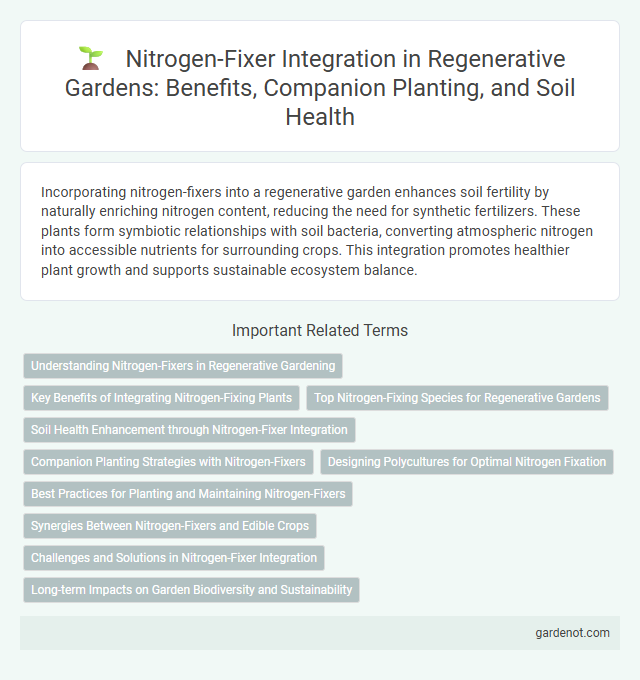Incorporating nitrogen-fixers into a regenerative garden enhances soil fertility by naturally enriching nitrogen content, reducing the need for synthetic fertilizers. These plants form symbiotic relationships with soil bacteria, converting atmospheric nitrogen into accessible nutrients for surrounding crops. This integration promotes healthier plant growth and supports sustainable ecosystem balance.
Understanding Nitrogen-Fixers in Regenerative Gardening
Nitrogen-fixers are essential bacteria or plants that convert atmospheric nitrogen into forms accessible to other plants, enriching soil fertility naturally. Integrating species like legumes or actinobacteria into regenerative gardens promotes sustainable nutrient cycling and reduces reliance on synthetic fertilizers. Understanding the symbiotic relationships between nitrogen-fixers and plant roots enhances soil health and optimizes plant growth in regenerative systems.
Key Benefits of Integrating Nitrogen-Fixing Plants
Integrating nitrogen-fixing plants into regenerative gardens enhances soil fertility by naturally converting atmospheric nitrogen into a form accessible to other plants, reducing the need for synthetic fertilizers. These plants improve soil structure and microbial activity, promoting a healthy and balanced ecosystem. Their inclusion supports sustainable agriculture by increasing crop yields and resilience against pests and diseases.
Top Nitrogen-Fixing Species for Regenerative Gardens
Top nitrogen-fixing species for regenerative gardens include legumes such as clover (Trifolium spp.), lupines (Lupinus spp.), and vetches (Vicia spp.), which enhance soil fertility by converting atmospheric nitrogen into bioavailable forms. Incorporating fast-growing nitrogen-fixers like alder trees (Alnus spp.) and tagasaste (Chamaecytisus proliferus) supports sustainable nutrient cycling, promoting healthier plant growth. Utilizing a diverse mix of these species fosters balanced nitrogen input while improving soil structure and microbial activity critical to regenerative gardening practices.
Soil Health Enhancement through Nitrogen-Fixer Integration
Integrating nitrogen-fixers like legumes and clover into regenerative gardens significantly improves soil health by naturally enriching nitrogen levels, reducing the need for synthetic fertilizers. These plants form symbiotic relationships with rhizobia bacteria, converting atmospheric nitrogen into bioavailable forms that enhance soil fertility and microbial activity. Enhanced nitrogen availability promotes robust plant growth, increased organic matter, and improved soil structure, driving sustainable ecosystem productivity.
Companion Planting Strategies with Nitrogen-Fixers
Integrating nitrogen-fixers such as clover, peas, and beans into companion planting strategies enhances soil fertility by naturally replenishing nitrogen levels essential for plant growth. These legumes form symbiotic relationships with Rhizobium bacteria, converting atmospheric nitrogen into a bioavailable form that benefits adjacent crops like corn, tomatoes, and leafy greens. Strategic placement of nitrogen-fixing plants within regenerative gardens reduces reliance on synthetic fertilizers while promoting biodiversity and soil health.
Designing Polycultures for Optimal Nitrogen Fixation
Designing polycultures for optimal nitrogen fixation involves integrating diverse nitrogen-fixing plants such as legumes, clovers, and vetches that naturally enrich soil fertility. These species work synergistically with companion crops, enhancing nutrient cycling and promoting robust plant growth without synthetic fertilizers. Implementing strategic plant arrangements and maximizing root symbiosis with nitrogen-fixing bacteria ensures sustained soil nitrogen levels critical for regenerative garden productivity.
Best Practices for Planting and Maintaining Nitrogen-Fixers
Plant nitrogen-fixers like clover, alfalfa, or lupines in rotation with main crops to enhance soil nitrogen levels naturally. Incorporate these legumes into cover cropping cycles to improve soil structure and reduce synthetic fertilizer dependency. Regularly monitor plant health and soil nitrogen content to optimize nitrogen fixation and maintain ecosystem balance in regenerative gardens.
Synergies Between Nitrogen-Fixers and Edible Crops
Integrating nitrogen-fixing plants such as clover, beans, and peas within regenerative gardens enhances soil fertility by naturally converting atmospheric nitrogen into bioavailable forms, reducing the need for synthetic fertilizers. These symbiotic relationships boost the growth and nutritional quality of adjacent edible crops like tomatoes, leafy greens, and root vegetables through improved nitrogen availability and soil health. The resulting synergy supports sustainable food production, promotes biodiversity, and strengthens ecosystem resilience in regenerative agricultural systems.
Challenges and Solutions in Nitrogen-Fixer Integration
Integrating nitrogen-fixing plants in regenerative gardens presents challenges such as establishing symbiotic relationships with soil bacteria and managing competition with existing vegetation. Optimizing soil pH, ensuring adequate organic matter, and introducing compatible Rhizobium strains can enhance nitrogen fixation efficiency. Implementing crop rotation and intercropping strategies supports balanced nutrient cycling and mitigates plant stress for sustainable garden productivity.
Long-term Impacts on Garden Biodiversity and Sustainability
Integrating nitrogen-fixing plants such as legumes into regenerative gardens enhances soil fertility by naturally enriching nitrogen levels, reducing the need for synthetic fertilizers. This practice supports long-term biodiversity by fostering diverse microbial communities and attracting beneficial insects, which contribute to a resilient ecosystem. Sustainable nitrogen fixation promotes nutrient cycling, improves soil structure, and sustains garden productivity over multiple growing seasons.
Nitrogen-fixer integration Infographic

 gardenot.com
gardenot.com